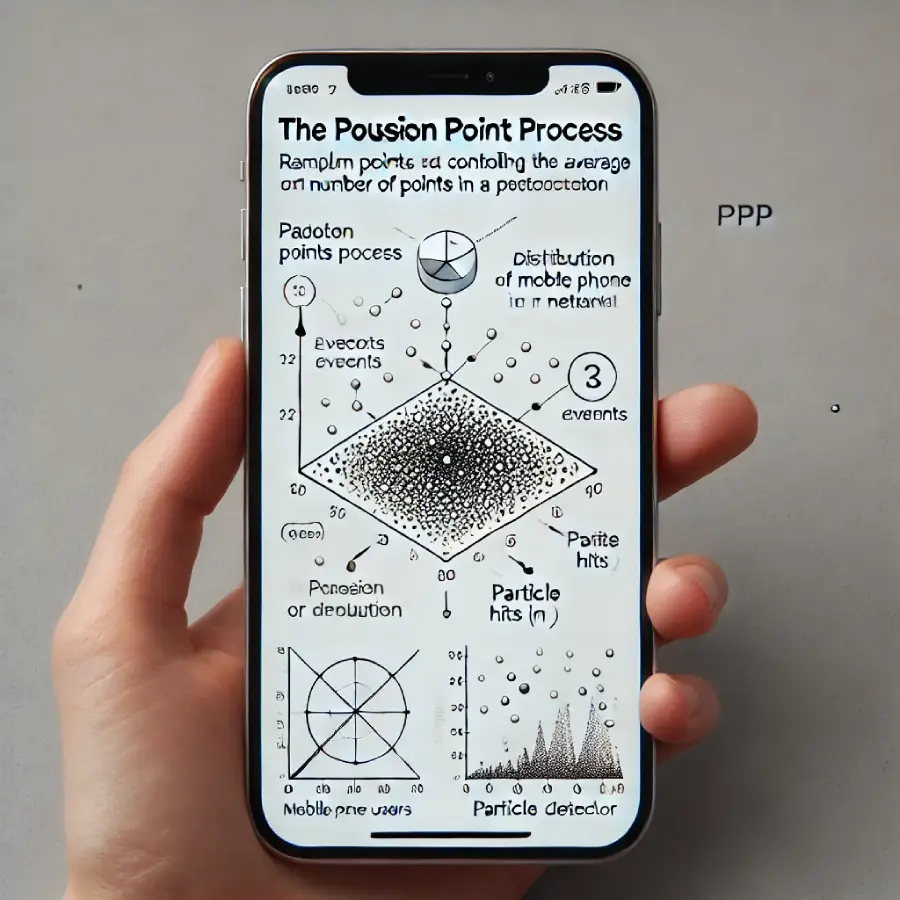Introduction
The Poisson Point Process (PPP) is a fundamental concept in probability theory and stochastic processes, widely used in fields like telecommunications, physics, and ecology. It provides a mathematical framework for modeling random events that occur independently in time or space. The Poisson Point Process is a natural extension of the Poisson distribution to higher dimensions, such as time, space, or any other continuous domain.
—
The Basics of the Poisson Point Process
1. Definition
The Poisson Point Process is a random process where points (events) occur independently of each other in a continuous domain, such as time or space. The process is characterized by a rate or intensity parameter \( \lambda \), which defines the average number of points per unit of the domain.
Formally, a Poisson Point Process is defined on a space \( S \) with a rate \( \lambda \). For any region \( A \subseteq S \), the number of points \( N(A) \) within \( A \) follows a Poisson distribution with mean \( \lambda \times |A| \), where \( |A| \) denotes the measure (length, area, volume, etc.) of the region \( A \).
2. Properties
– Independence: The number of points in disjoint regions are independent of each other.
– Poisson Distribution: The number of points in any region \( A \) follows a Poisson distribution with mean \( \lambda \times |A| \).
– Homogeneity: If the process is homogeneous, the rate \( \lambda \) is constant across the entire space. If the rate varies across the space, the process is called an inhomogeneous Poisson Point Process.
3. Mathematical Formulation
For a Poisson Point Process with rate \( \lambda \) on a region \( A \), the probability of observing \( k \) points within \( A \) is given by:
\[
P(N(A) = k) = \frac{(\lambda |A|)^k e^{-\lambda |A|}}{k!} \quad \text{for} \quad k = 0, 1, 2, \dots
\]
Here:
– \( N(A) \) is the number of points in region \( A \).
– \( \lambda \) is the rate parameter, representing the expected number of points per unit area.
– \( |A| \) is the size of the region \( A \) (e.g., length, area, or volume).
4. Relation to the Poisson Distribution
The Poisson Point Process generalizes the Poisson distribution by describing not just the number of events in a fixed interval but the entire spatial or temporal distribution of these events. The number of points in any finite region of the space follows a Poisson distribution, with the mean proportional to the size of the region.
—
Applications of the Poisson Point Process
1. Telecommunications
In telecommunications, the Poisson Point Process is used to model the distribution of users or devices in a network, such as the locations of mobile phones in a cellular network. The PPP can help in analyzing network coverage, signal interference, and resource allocation by modeling the random distribution of users.
2. Physics
In physics, the Poisson Point Process models the random distribution of particles or events in space. For instance, it can be used to describe the distribution of cosmic rays hitting a detector or the location of atoms in a material.
3. Ecology
Ecologists use the Poisson Point Process to model the distribution of species in a habitat. For example, the distribution of trees in a forest or the locations of animal sightings in a survey area can be modeled using a PPP.
4. Queueing Theory
In queueing theory, the Poisson Point Process models the arrival of customers or jobs to a service point. For example, the arrival times of customers at a bank or calls at a call center can be modeled as a PPP, where each arrival is an independent event.
—
Variants and Extensions
1. Inhomogeneous Poisson Point Process
An inhomogeneous Poisson Point Process allows the rate \( \lambda(x) \) to vary across space. This variant is useful when the intensity of events is not uniform, such as modeling population density in urban and rural areas.
2. Marked Poisson Point Process
In a Marked Poisson Point Process, each point in the process is associated with a “mark,” which can represent additional attributes like the type or size of the event. For example, in a wireless network, each user’s location (a point) might be marked with their data usage or signal strength.
3. Compound Poisson Process
A Compound Poisson Process extends the Poisson Point Process by allowing each point to generate a random number of sub-events. This is useful in finance, where a compound Poisson process might model the total claim amount in an insurance portfolio, with each claim representing a random amount.
—
Conclusion
The Poisson Point Process is a powerful tool in modeling random events distributed over time, space, or other continuous domains. Its simplicity and flexibility make it applicable across various fields, from telecommunications and physics to ecology and finance. By understanding the Poisson Point Process, researchers and practitioners can effectively model and analyze complex systems where events occur randomly but with a well-defined average rate.

